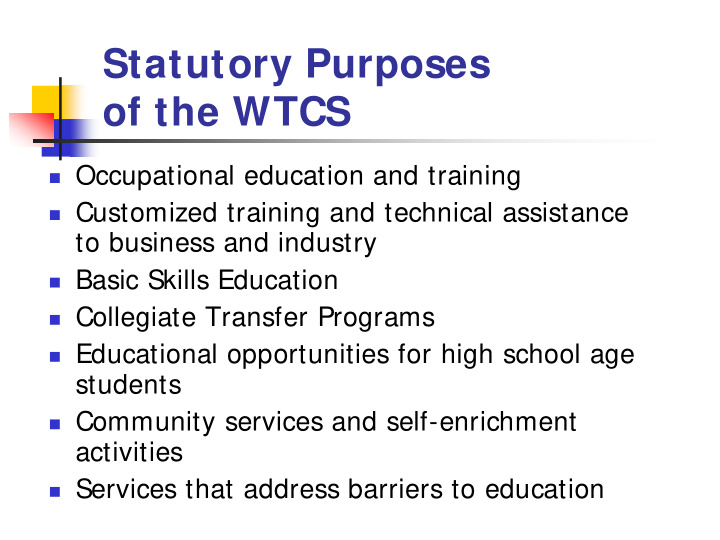



Statutory Purposes of the WTCS � Occupational education and training � Customized training and technical assistance to business and industry � Basic Skills Education � Collegiate Transfer Programs � Educational opportunities for high school age students � Community services and self-enrichment activities � Services that address barriers to education
36.31 � …the technical college system board shall not, without the approval of the board of regents, broaden its system’s collegiate transfer program offerings beyond those in existence during the 1972-1973 academic year.
Applied Associate Degree � The Applied Associate degree is awarded for successful completion of a program primarily intended for employment. About 30% of the course work is in general education; the remaining 70% is in technical studies. The Associate in Applied Science Degree is the primary degree offering of the Wisconsin Technical College System.
Liberal Arts Associate Degree � The Associate in Liberal Arts is awarded for successful completion of a liberal arts and sciences curriculum designed to constitute the first two years of a baccalaureate degree in the arts, humanities, social sciences, and similar areas. At least 90% of the course work is in general education; the remaining 10% may be in general education or technical studies.
Pre-Professional Associate Degree � A Pre-Professional Associate degree is designed to meet the needs of the two-year college student who is planning to transfer to a baccalaureate degree program in a specific professional field. At least 60 to 65% of the course work is in general education; the remainder of the course work is drawn from lower division courses in the career field.
The WTCS Collegiate Transfer program approval process justifies the need and cost-benefit of offering a new Collegiate Transfer Program at a WTCS district.
I ndication of I nterest � At this phase, the district indicates their interest in pursuing a collegiate transfer program. In addition, a program specific timeline is developed to identify specific dates for the completion of each phase of the process.
Scope Proposal Phase � The second step is intended to provide the preliminary need and cost data to support further investigation of the program. Initial District is a key step at this point in the process.
Need Demonstration � During this phase, need and cost data is compiled and analyzed. In addition, information regarding collaborative inter- institutional opportunities and impacts of opening a new program on existing programs and resources is provided.
Program Proposal � This is the final analysis of all preceding information. Also presented are issues related to faculty development and facilities. At this stage, if all criteria has been met, the proposal is recommended to the State Board for final approval.
Program I mplementation � This is the stage at which the proposal is submitted by the WTCS State Board to the UW Board of Regents for their review and action. Following the Board of Regent action, the System Office will notify the District of the action taken, and if approved, the District will be able to begin to offer the program.
Review and Approval Process � Communication between WTCS and UWSA. � Approved by District and State WTCS Boards. � Pre-professional: Board approves general philosophy and structure. � UWSA approves specific disciplinary degrees. � Liberal Arts: Board approves each program.
Program Criteria � Recommendation from WTCS Board. � Reviewed by UWS institutions. � Demand from a student population not currently served by a WTCS or UWS institution. � Meets appropriate accreditation standards.
Program Criteria (continued) � Partner institution is authorized to offer professional degree.* � Consideration of concerns of UW institutions. � Collaboration. � Efficient and Effective use of resources. * for pre-professional programs only
Questions and Discussion
Recommend
More recommend